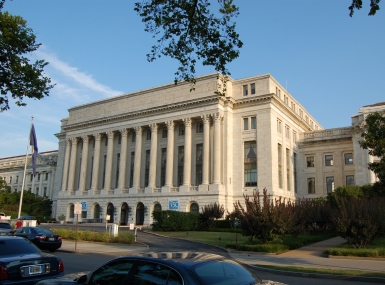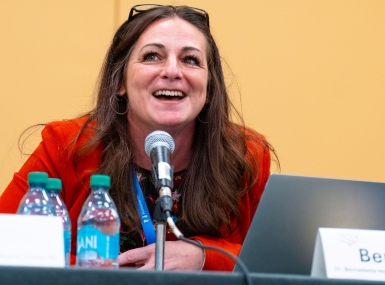Washington County, Md. targets addiction in its jail

Seeing nearly two-thirds of its population entering with opioid addiction as their primary substance abuse issue, the Washington County, Md. Detention Center has made addiction treatment a priority, with more measures still to come.
It’s a hard pivot from earlier jail policy, which was mostly just detox, with no preparations for returning to the general population after release. The county’s health department assesses inmates before their release and a contractor administers Naltrexone, a medication that can decrease the desire and dependency on opioids.
“They used to have individuals overdosing in the bathrooms before they even left the jail,” said Victoria Sterling, Washington County’s director of behavioral health. “There wasn’t any real treatment in the jail. Now, we meet people where they are instead of where you want them to go because that’s not always going to happen. Those expectations (are) going to be detrimental to their health.”
Washington County sits at the junction of two interstates and has been designated a High Intensity Drug Trafficking Area by the Drug Enforcement Administration.
“You can be in Pennsylvania, West Virginia or Virginia in 10 minutes,” Sterling said. “We have a large transient population, and people can do some ‘doctor shopping,’” to access more prescription drugs.
Inmates who have dealt with opioid addiction receive overdose-reversing Naloxone upon release, an exclamation point at the end of a sentence that involved plenty of therapy. It’s the culmination of the Jail Substance Abuse Program, a nine-week program that includes assessments, counseling, three hours of group therapy each week and, next year, the addition of medication-assisted treatment in the form of Suboxone, which is already available to pregnant inmates. And Sterling says one of the most crucial things the county can give its inmates to help their health outcomes is information.
“One of the most important things that people need to know is harm reduction principles, because it’s going to be the most important tool we have fighting this epidemic,” Sterling said. “It opens doors to resources.”
She has also seen strong support for the county’s drug court, which includes counseling from people who have beaten their addiction.
“I’m seeing peer counselors who were in treatment earlier in my career,” Sterling said. “That’s a sign this is working.”
Washington County recently changed eligibility rules so that inmates can choose the program, rather than just being ordered by the court to participate.
“That really removes an obstacle for people,” she said.
Sterling previously worked for neighboring Frederick County, Md. and in the private sector before coming to Washington County. She has seen attitudes toward addiction, outside of the healthcare field, change during her career.
“I came in when things were starting to change,” she said. “When I started, the jail focused on punishment, more than treating addiction problems. Now I see things evolve, particularly having access to treatment and reentry services.”
She noted that the jail now offers comprehensive discharge plans. Re-entry services, once just nine months, have been extended to a full year before release. And inmates are reenrolled in Medicaid, which 30 percent of Washington County’s residents are eligible for.
“Before, we did plan, and maybe it was carried out, but you never knew,” she said. “There wasn’t coordination or follow-up.”
She credited Sheriff Douglas Mullendore with the change.
“He’s very supportive,” Sterling said. “He knows we can’t arrest our way out of the problem. And the jail was overcrowding with people who needed treatment.”
In addition to substance abuse services, the jail is also offering wellness training, which includes mindfulness, yoga, nutrition consultation, meditation and integrative health.
“They touch on things like how sleep, stress and nutrition affect your mood,” Sterling said. “All helpful for improving overall health when they’re out of jail.”
There are still challenges. If an inmate posts bond or is transferred to the state prison system, their treatment is interrupted.
“The state system doesn’t do anything quite like this,” Sterling said.
Washington County’s program treated 350 inmates in 2019 and it is funded by the state, with supplemental state grants.
Addiction recovery is still an uphill battle, and opioids aren’t the end of it.
“Even when you take away the opioids, they’ll still have alcohol problems,” she said. “We’ve always had issues with substance abuse, alcohol will always be prevalent here. But I’m hopeful we’re giving people the tools to succeed once they are released.”
Attachments
Related News

U.S. Department of Agriculture announces reorganization
On July 24, U.S. Secretary of Agriculture Brooke Rollins announced a major reorganization of the U.S. Department of Agriculture (USDA) that will relocate thousands of federal employees, restructure regional offices and consolidate administrative services and operations. The changes are expected to reduce USDA’s footprint in Washington, D.C. and shift more personnel to regional hubs across the country.

County officials shed light on childhood education and care
Inadequate childcare causes American workers to lose between 9 million and 26 million hours of work in any given week and has a negative impact on children’s development.

Counties can help troubled youth thrive
Combatting crime among youth means providing them with enriched education environments and mentorships, access to green spaces and opportunities for social connection and skill strengthening according to Bernadette Hohl, from the Philadelphia Department of Public Health.
